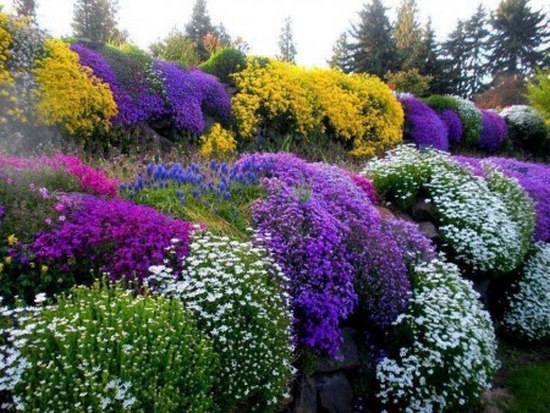Many gardeners (and not just beginners) complain that they are unable to grow perennials from seeds, although annuals always grow without problems.
|
Such bright perennials |
Let me remind you of the basic conditions for successfully growing seedlings of perennial flowers:
-
- Don't be late with sowing: seedlings of perennial plants develop more slowly than annual ones. The beginning of February is the time to sow.Start with plants that take a long time to germinate. Seed packets usually indicate at what temperature they germinate and after how many days.
- Soil mixture. Buy peat soil mixture for flower crops (pure peat is not suitable for growing seedlings) and river sand in bags. Select all large inclusions from the earthen mixture and mix with sand in a ratio of approximately 3:1.
- Containers. The containers should be 5-6 cm deep with holes in the bottom. Pour 0.5 cm of sand onto the bottom, fill with soil, compact, 0.5 cm should remain to the edge of the container. The surface must be absolutely flat. Moisten with a spray bottle.
- Seeds. If necessary, soak them for 12 hours in zircon. In soaking The seeds of all essential plants and those whose germination period is coming to an end are needed.
- Sowing. Lightly press large seeds into the soil; gently drop small seeds from a piece of paper bent in half onto the soil surface using the tip of a pointed match. Lightly sand all crops. Spray with water and cover with something transparent. Place the containers somewhere on a shelf until germination (but not on the windowsill). The average temperature should be 18-20 degrees. Shoots of various types of flowers appear in one to three weeks.
- After the first shoots appear We place the seedlings on the windowsill. For further growth, the temperature must be +15 +18 degrees. We install screens with a height of at least 30-40 cm (cardboard boxes cut diagonally from the ends can be used under the screens). The screens will protect against warm air coming from radiators and will allow you to maintain a lower temperature. Cover the side of the screen facing the window with foil - this will give additional light reflected from the window.Start every morning by examining your “pets.”
- Thinning. Carefully thin out the grown seedlings with tweezers, removing excess and weak ones. The remaining largest and strongest seedlings, given space, will develop better.
- Fertilizers. At the stage of one or two true leaves, once every 7-10 days, begin to feed the seedlings with a complex water-soluble fertilizer for seedlings with a nitrogen content of no more than 5-10 percent. When preparing nutrient solutions, follow the proportions indicated on the fertilizer packaging. It's better to put less than more. The optimal combination of light and fertilizers allows the seedlings to grow compact and healthy. With a lack of light and a large amount of nitrogen, the plants stretch out, so with regular feeding, the seedlings need to be supplemented with light.
- Watering. It is necessary to water seedlings of perennial flowers very sparingly, literally in a drip manner. Water first along the sides of the container so that the moisture reaches the bottom of the container, where the roots are located, and then carefully between the plants. In the evening, before turning off the lighting, lightly spray the seedlings with a sprayer - this procedure will increase the air humidity and lower the temperature slightly. Water it must be settled, or even better - snow, which the seedlings “rejoice” in. Do not flood the crops: the seedlings will be affected by “black leg” or the roots will rot.
- At the first sign of illness carefully spill the soil in the container with a pale pink solution of potassium permanganate and forget about watering until the top layer of soil has completely dried.
- Transfer. In the “nursery” age, seedlings tolerate transplantation well, even those that do not like transplantation.When two or three true leaves are formed, the plant can be planted in separate cups or in a wider and deeper container at a greater distance. If few seeds have sprouted, they can be left untouched until planted in open ground.
At the beginning of May, you can take the seedlings to the dacha or put them in the garden near your house. After placing containers with seedlings in a box, find a shady, secluded place, and do not forget to water. In the fresh air, the seedlings will harden and better tolerate transplantation. In the second half of May, plant the seedlings in a garden bed in a semi-shaded place, and at the end of summer - in a permanent place in the sun or shade, depending on the preference of a particular plant.
Compliance with all the little details will make it possible to grow seedlings of polygons, which are not cheap, or which are not sold at all. I wish you success!



 CUCUMBERS NEVER GET SICK, I'VE BEEN USING ONLY THIS FOR 40 YEARS! I SHARE A SECRET WITH YOU, CUCUMBERS ARE LIKE THE PICTURE!
CUCUMBERS NEVER GET SICK, I'VE BEEN USING ONLY THIS FOR 40 YEARS! I SHARE A SECRET WITH YOU, CUCUMBERS ARE LIKE THE PICTURE! You can dig a bucket of potatoes from each bush. Do you think these are fairy tales? Watch the video
You can dig a bucket of potatoes from each bush. Do you think these are fairy tales? Watch the video
 How our fellow gardeners work in Korea. There is a lot to learn and just fun to watch.
How our fellow gardeners work in Korea. There is a lot to learn and just fun to watch. Eye trainer.The author claims that with daily viewing, vision is restored. They don't charge money for views.
Eye trainer.The author claims that with daily viewing, vision is restored. They don't charge money for views. A 3-ingredient cake recipe in 30 minutes is better than Napoleon. Simple and very tasty.
A 3-ingredient cake recipe in 30 minutes is better than Napoleon. Simple and very tasty. Therapeutic exercises for cervical osteochondrosis. A complete set of exercises.
Therapeutic exercises for cervical osteochondrosis. A complete set of exercises. Which indoor plants match your zodiac sign?
Which indoor plants match your zodiac sign? What about them? Excursion to German dachas.
What about them? Excursion to German dachas.